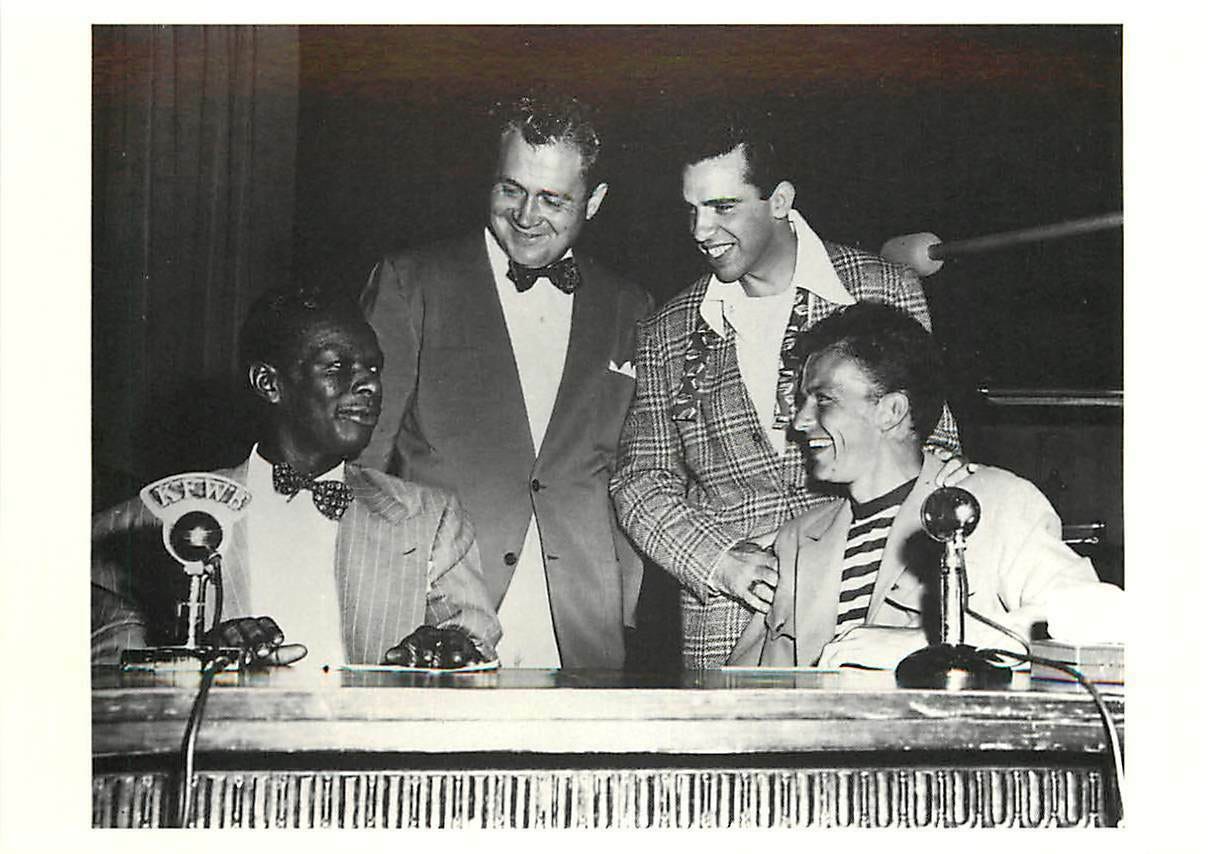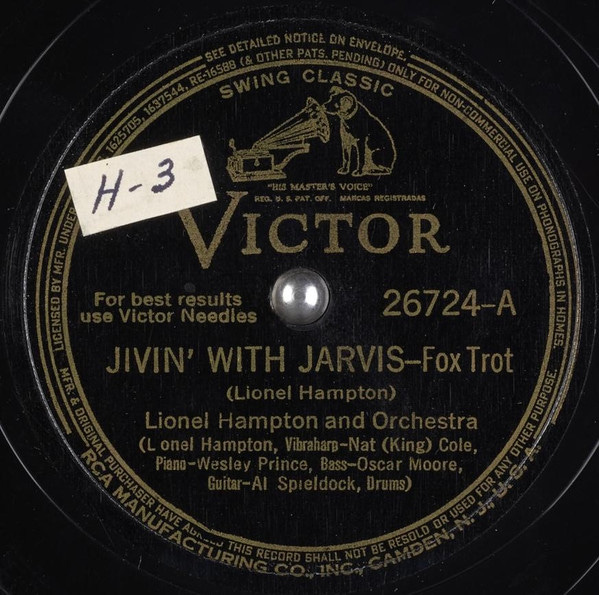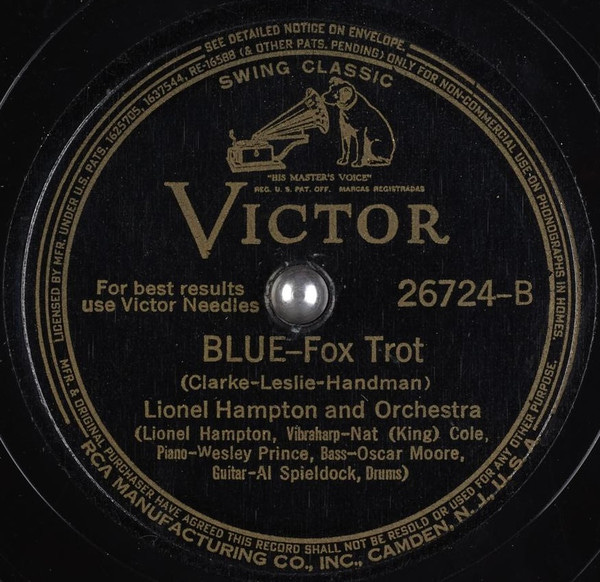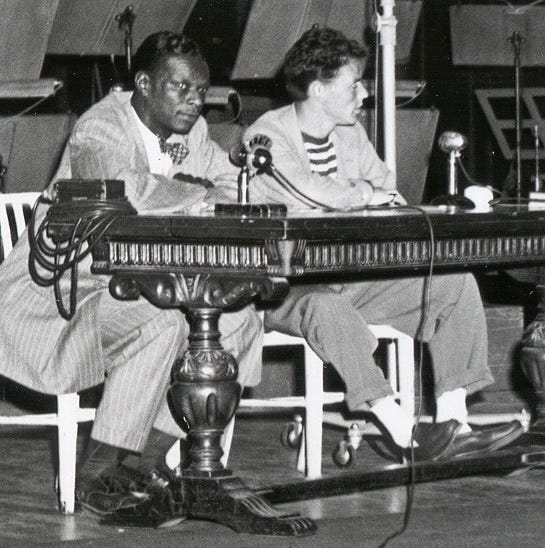
My buddy Jordan Taylor - the ultimate Nat King Cole researcher and discographer - and I conceived of this series, mainly because whenever there’s a photo of Nat King Cole and Sinatra together, they are almost invariably identified with the wrong dates, locations, and other misinformation. This is our attempt to sort all of that out, hopefully with the correct details. (Special Thanks to Jordan Taylor, of course, as well as the Frank Tank-Nat Pack, especially Michael Kraus and Rob Waldman.)
Sinatra and Nat King Cole crossed paths repeatedly over a period of almost 20 years, from 1945 to 1965 - the last occasion being Cole’s funeral on February 18, 1965, at St. James Episcopal Church on Wilshire Boulevard, a month before what would have been Cole’s 46th birthday and, coincidentally, a few days before the assassination of Malcolm X.
As far as we can determine, the first time they were in the same place at the same time was on July 21, 1945, when they both were panelists on Can You Tie That?, a program hosted by the pioneering broadcaster Al Jarvis on local Los Angeles radio KFWB.
Commercial recordings were played frequently over the radio almost from the introduction of the medium, but a claim can be made that Al Jarvis (1909-1970) was the first modern, mainstream “disc-jockey” in the sense that we understand the term today. There are several good biographical articles on the net, including this one by Laurence W. Etling.
The story generally goes that Jarvis was the first to conceive of a regular program of playing new records on the air, much the way deejays would do mostly after the war. In 1934, Jarvis launched his show on KFWB, which he titled Make Believe Ballroom (Martin Block, then also working at KFWB, would soon borrow both the title and the concept, for WNEW New York, and become considerably more famous with it - at least to us East Coasters.) Jarvis was in the right place and the right time to serve as a cheering section for the whole of the big band era, and developed close personal and professional relatoinships with most of the major bandleaders and musicians.
During the era of segregation, Jarvis made a point to feature both white and Black musicians, and also invited many of them to participate in on-air interviews. To quote Etling:
Bob Weiss, later European Director for Capitol Records, began his music career as a producer for Make Believe Ballroom. He recalled that the avant-garde Kenton had trouble getting his music heard. “In the early days, a lot of stations were more or less not inclined to play Stan. It was too far out, but Al was always a pioneer. He plugged Stan and he plugged Nat. He was the first one to really give air time to Nat King Cole” (Interview).
Due to the racial climate of the day, black musicians had difficulty getting air time, and Jarvis was one of the few disc jockeys to play their records. According to Hampton “he would let the black musicians all come do interviews on his radio show. He was very liberal about that. […] He gave blacks a lot of play” (Hampton, Interview). According to Weiss, “Nat could have been relegated to what they called `race records,’ but Al did not believe that […] He was a very liberal person; he didn’t believe there was a color line” (Weiss, Interview). Jarvis became vice president of the Inter-Racial Film and Radio Guild, an organization formed to protect the interests of minorities in the entertainment industries (“IFRG”; “Show Time”).
Famously, in 1940 Lionel Hampton recruited Nat King Cole and the rest of his trio, with Oscar Moore and Johnny Miller, as well as drummer Al Spieldoc (then married to Helen Forrest). Among the eight titles recorded over two sessions, one was a riff number titled “Jivin’ with Jarvis.” It’s credited to Hampton, but it’s clearly Cole’s work, it sounds exactly like many instrumentals he would compose for the trio, like “Jumpin’ with the Mop” (1941). There’s a vocal chorus of sorts by the trio, in which they chant the song’s title, in between brief breaks by Hampton, which are followed by solos from Moore, Cole and then Hampton. The trio chant returns at the end, followed by a brief scat break from the leader and then the coda.


Jarvis was sufficiently flattered by “Jivin’ with Jarvis” to make it his theme song, and he apparently gave props to Cole for it rather than Hampton. According to Etling, Cole was a frequent in-person guest on Saturday afternoons. Hampton himself not only took credit for it, but he also claimed that by late 1940 it was “the rage out here everywhere. Other bands are adding it to their books as fast as arrangers can knock it out” (“Hampton’s” 7).” This idea seems to be an invention of the vibraphonist’s - I can’t find any recording, any aircheck, any trace of any other performance of “Jivin’ with Jarvis” beyond the original Hampton-Cole RCA 78.
By 1945, Jarvis’s popularity had grown to the point where he could summon three or four leading musical figures each week to join him for a program of chat and recordings titled Can You Tie This? This seems to be the forerunner of later shows like Jukebox Jury and the 1956 TV series Words About Music (hosted by Frank DeVol), in which prominent singers and musicians would listen to new records and offer their opinions. The show was popular enough that as Metronome reported, “A live audience of about 700 youngsters witnesses this broadcast every week.”
Alas, no episodes of Can You Tie This? survive - although plenty of photographs do. The critic, producer, and columnist Dave Dexter seems to have been a regular - he’s prominent in many photos, and some of the best shots come from his own archive.

On July 21, 1945, the main guests were Sinatra, Nat King Cole, and Buddy Rich - along with Dexter and announcer Joe Yocum. We are fortunate that a few photos exist. Sinatra had just returned from a successful but controversial tour of Europe as part of the USO and was gearing up to launch his next big radio series, The Old Gold Show, in September. Cole and his Trio had already played runs at the Orpheum Theater in Los Angeles and The Golden Gate Theater in San Francisco earlier than month, and the night before (Friday July 20th), they had opened at the Casa Manana supper club in Culver City.
Alas, we have no idea what records they listened to (possibly the King Cole Trio’s latest release, "I'm A Shy Guy” backed with “I Thought You Ought to Know" on Capitol 208) or what comments they might have made. I like to think that they played selections from the new original cast album of Rodgers & Hammerstein’s Carousel - because as you can clearly see, Sinatra is wearing his striped Billy Bigelow T-shirt.
Sinatra and Cole would next meet four months later at the CBS Radio Theater #3, 1697 Broadway, for an episode of Sinatra’s Old Gold Show - and for that occasion, we do have both photographic and recorded audio evidence.
Very Special thanks to the fabulous Ms. Elizabeth Zimmer, for expert proofreading of this page, and scanning for typos, mistakes, and other assorted boo-boos!
Sing! Sing! Sing! : My tagline is, “Celebrating the great jazz - and jazz-adjacent - singers, as well as the composers, lyricists, arrangers, soloists, and sidemen, who help to make them great.”
A production of KSDS heard Saturdays at 10:00 AM Pacific; 1:00PM Eastern.
To listen to KSDS via the internet (current and recent shows are available for streaming.) click here.
The whole series is also listenable on Podbean.com, click here
Wednesday, February 7
7:00PM (EST) - THE NEW YORK ADVENTURE CLUB presents:
A Brand new presentation!
'CAROUSEL: Rodgers & Hammerstein's Darkest Broadway Show' Webinar
click_here
Wednesday, February 7
9:30PM (EST) - Will Friedwald's CLIP JOINT presents:
CAROUSEL Encores!
No Cover Charge!
Click_Here
SLOUCHING TOWARDS BIRDLAND is a subStack newsletter by Will Friedwald. The best way to support my work is with a paid subscription, for which I am asking either $5 a month or $50 per year. Thank you for considering. (Thanks as always to Beth Naji & Arlen Schumer for special graphics.) Word up, peace out, go forth and sin no more! (And always remember: “A man is born, but he’s no good no how, without a song.”)
Note to friends: a lot of you respond to my SubStack posts here directly to me via eMail. It’s actually a lot more beneficial to me if you go to the SubStack web page and put your responses down as a “comment.” This helps me “drive traffic” and all that other social media stuff. If you look a tiny bit down from this text, you will see three buttons, one of which is “comment.” Just hit that one, hey. Thanks!











